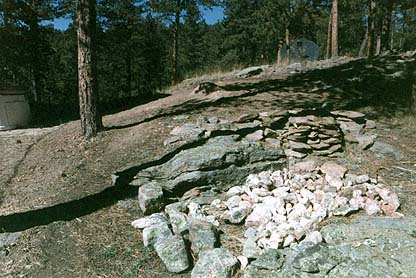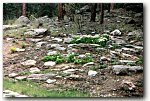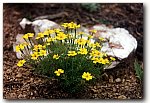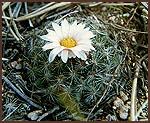

| We have so many wild flowers that I have not planted any flower gardens. To me, cultivated flowers such as marigolds, zinnia, cleome, canna, and daisies that I grew in my eastern gardens do not seem appropriate to a mountain landscape.
However, in 2000 I started two flower gardens - a rock garden and a xeriscape garden - that I believe will be harmonious with our natural setting. In these gardens, I plan to use wild flowers and other high altitude plants. I expect these gardens to take four or five years to complete and will update this page with my progress. |
|
Living in the rocky Mountains, we have rocks of all sizes and shapes. What better place to create a rock garden? After researching alpine gardening techniques and plants, I have started my rock garden. Click here for some links that I found to be useful for creating a rock garden. Behind our house, the land continues to rise towards a crest on our north east property corner. A rocky area was cut into for the house. Not many plants grew on this cut and 17 years after the house was built, the disturbed area had mosses growing but very few wild flowers or grasses. Moreover, the graders pushed excess subsoil into a mound right behind where our hot tub is located, obstructing our view to the undisturbed rocks and the pine forest beyond. |
||
 |
This first picture is a view of the site for my rock garden from a second story balcony on our house. The area in the middle shows the subsoil mound.
I had already started some digging as can be seen by the freshly disturbed dirt and excavated rocks. The original, gray rocks are much larger then this picture portrays and will remain where they are naturally situated. Although this picture was taken in August, notice how little vegetation is growing.
|
|

|
This second picture was taken of the same area from ground level. It also shows the unsightly mound of subsoil. The soil is mostly decomposed granite and will drain extremely well but is very poor in organic matter and nutrients. | |
 |
This third photograph shows the rock garden site after I removed the subsoil mound and restored the original grade. I also created a gentler slope towards the hot tub so grasses and other plants have a better chance of growing.
Except for the two large boulders and the quartz, these are the rocks I removed as I dug out the subsoil. I stacked the rocks according to size and flatness. Most of the larger, rounder rocks I returned to the excavated area. The smaller and/or flatter rocks I plan to use in other landscaping projects.
|
|
 |
Here is the garden at the end of 2000. After removing zillions (well, maybe 150 or so) of buckets of subsoil, I replaced many of the rocks and added some pieces of quartz. I found randomly placing rocks to be difficult, perhaps because I tend to be very organized. I also put about 4 inches of precious compost around the rocks.
The scattering of quartz may look unnatural to you but I observed quartz placement like this in many natural settings while hiking. The hillside to the east already has about 20 pieces of quartz that occurred there naturally. Besides, I really like quartz... |
|
|
|
||
I planted rock garden seeds indoors in March and then moved the seedlings to my temporary greenhouse in April. Click here for a list of the rock garden plants I grew this first season. I also added more rocks to the garden to create small terraces that I thought would make better planting spaces on the steep slope. Prior to making an unplanned trip back east in early May, I planted the rock garden when the seedlings were still tiny and the weather quite cold. Jack watered the garden during my absence and kept the plants alive. Here is a view of the rock garden in June. All the plants survived in spite of my (unintentional) ill treatment! |

|
|
This is my rock garden in August. Feverfew, blooming in white, was the one plant I did not feel fit in with our Rocky Mountain environment but it grew with the most vigor and was, of course, the only plant the deer and rabbits did not eat. Most of the other plants seemed to be doing ok. I am looking forward to Spring 2002 to see what plants survived our cold but dry winter and will update the Rock Garden Plant table with the results. |

|
|
I planted some annuals to fill in spaces while the perennials are getting established. Here is a gem marigold. It grew quite happily in full sun and mostly decomposed gravel! I'll plant more of these next year. |

|
|
|
Our mountain area is designated as "semi-arid". Although some years we get summer thunderstorms every afternoon, the soil remains very dry and parched due to the intensity of the sun. Dry land gardening intrigues me and I am planning to create a xeriscape garden after I finish removing the excess dirt from the rock garden area. So far, minimal progress has been made on the garden itself but I have begun to collect xeriscape plant seeds.
|
||
| I plan to put the xeriscape garden on the south east facing hill below our house. Early in my gardening attempts here in Pine, I placed a garden terraced with rail road ties on part of the hill side. Even watering every day, I could not give the plants (tomatoes, strawberries, cabbage, etc.) enough moisture to last through the afternoon sun; every plant would desiccate and turn brown. I think (and hope) this arid, hot area will make an ideal spot for a dry land garden. |
 |
|
| This is a mountain ball cactus that I planted at the edge of the dry area below the ponderosa pines in 1987. It was growing in the newly cut portion of our driveway so I transplanted it. Some summers, we have penstemon and wild geraniums growing here but usually not too much survives, not even grasses. I will need to vastly improve the soil before planting. |
 |
|
|
|
||
